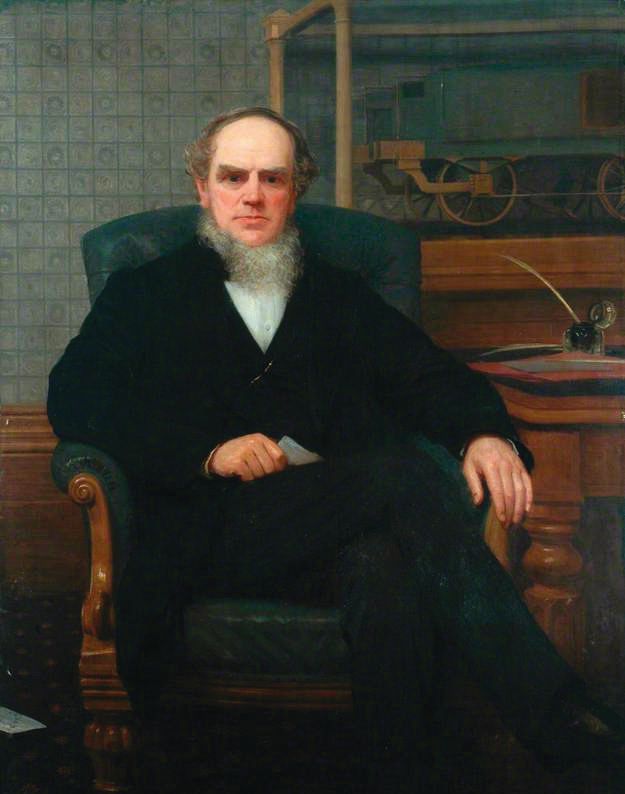Finding efficiencies
Evan Zabawski | TLT From the Editor February 2016
Necessity is the mother of invention.

John Ramsbottom seated in front of a model showing his water scoop. (Photo courtesy of the BBC, www.bbc.co.uk/arts/yourpaintings/artists/william-percy.)
DEVELOPING NEW PRODUCTS REQUIRES A KEEN MIND, one like that of John Ramsbottom. Born in 1814, he grew up in West Yorkshire, England. His father, who owned the first steam-driven cotton mill in the valley, gave him a 6-inch lathe, and John set to work constructing various models of steam engines.
He rebuilt and erected the engine in his father’s mill which included “a larger cylinder of 18 inches diameter and 4 feet stroke, a new beam, connecting-rod, air-pump, and condenser… he also designed and fitted up new side pipes with slide-valves, and a new parallel-motion (
1).” He then applied the new illuminant, coal gas, to light the mill and later designed and built an automatic machine to manufacture cut nails.
He also patented the weft fork, a device which stops the motion of the shuttle the instant the weft (crosswise threads) breaks. This enabled looms to work at a high speed and allowed one weaver to attend to two or three looms at a time. This was his most notable invention before he went to work at age 25 for Sharp, Roberts and Co., a manufacturer of locomotive engines and cotton-spinning machinery.
Ramsbottom’s focus switched to the construction and working of locomotives, resulting in him developing a telescopic boiler, solid coupling rod ends, weldless steel tires forged and rolled from conical ingots and portable appliances for reboring cylinders and planning up valve-faces of locomotives
in situ.
One of his most popular inventions was the tamper-proof duplex spring safety valve. It replaced the existing pressure relief valves that relied on a weight for closure but could open unexpectedly when the engine hit a bump in the track. Early designs that included a spring led to over-tightening as a manner of marginally improving the performance of the steam engine but at the expense of safety. The Ramsbottom valve became the universal standard for many years, however its complexity had the potential for incorrect assembly, leading to failure.
He had a more positive and resilient impact with his invention of the water trough (aka track pan) in 1860. For express trains to operate nonstop, they needed a method of replenishing their water supply without stopping. Ramsbottom selected a section of level track several hundred yards long, built a shallow trough in between the rails and filled it with water. A train was equipped with a water scoop that could be lowered into the trough, and the speed of the train would drive the water up the scoop into the tender. The advent of the water scoop precipitated the need for Ramsbottom to develop a form of speed indicator as well.
When diesel locomotives were introduced in the 1950s, water troughs were still necessary since passenger vehicles were heated by steam. Their usage continued until the late 1970s, at which time the remaining cars were converted to electric heat.
Nonstop travel was further enabled by Ramsbottom with the first commercial displacement lubricator, invented in 1858 but patented and improved in 1860. The basic design allowed steam to enter the lubricator—where it would condense and sink—and thereby displace lubricant into the delivery pipes to be atomized in the steam pipes before being delivered to valves and cylinders. The rate of oil feed was dependent on the engine doing work (it could not operate while a locomotive was coasting) and would increase in colder weather since the steam would condense faster. These remained in use until the 1920s.
A portion of new product development requires a problem-solving mind, but to truly become innovative one has to first perceive the areas of needed improvement—like John Ramsbottom. Though most of his innovations are now defunct, his ability to perceive a necessity and invent a solution remains an inspiration to others seeking to develop well-received new products.
REFERENCE
1.
The Institution of Mechanical Engineers. (1897),
Proceedings - The Institution of Mechanical Engineers, Parts 1-2, p. 236.
 Evan Zabawski, CLS, is a business development/reliability specialist for ALS Tribology in Calgary, Alberta, Canada. You can reach him at evan.zabawski@alsglobal.com
Evan Zabawski, CLS, is a business development/reliability specialist for ALS Tribology in Calgary, Alberta, Canada. You can reach him at evan.zabawski@alsglobal.com.